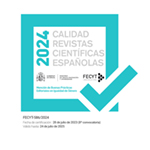Hechos frente a palabras: la influencia de los temas en el proceso de formación de la agenda pública
Resumen
Este trabajo intenta mostrar cómo las características de un tema pueden incidir sobre el ciclo de atención que le prestan los ciudadanos. Partiendo de diferentes teorías sobre la formación de la agenda pública y recurriendo a la triangulación múltiple, analiza la evolución de las prioridades otorgadas por los españoles a los temas de la vivienda, la banca y los desahucios. Los variables independientes examinadas son: el contexto cultural y la coyuntura económica y política; las condiciones reales de los problemas y las políticas públicas; los comportamientos de los actores; y los intereses y valores de los individuos. Los resultados obtenidos muestran como la influencia de estos factores fue distinta en cada tema: mientras que en unos lo determinante son las políticas y la evolución de las condiciones reales del problema, en otros lo es la retórica presidencial, la atención de los medios y la narrativa de los movimientos sociales. El contexto y los intereses y valores de los individuos influyen también, introduciendo sesgos específicos en cada tema, pero con una intensidad moderada. El que influyan más sobre la agenda pública los hechos (las políticas y la evolución del problema) o las palabras (la retórica presidencial, la narrativa de las coaliciones promotoras y la atención de los medios) depende del tema y, en particular, de si los ciudadanos lo conocen o no a través de su propia experiencia y la de los grupos con los que se relacionan
Descargas
Descarga artículo
Licencia
Derechos de autor 2022 Cuadernos de Gobierno y Administración Pública

Esta obra está bajo una licencia internacional Creative Commons Atribución 4.0.
La revista Cuadernos de Gobierno y Administración Pública, para fomentar el intercambio global del conocimiento, facilita el acceso sin restricciones a sus contenidos desde el momento de su publicación en la presente edición electrónica, y por eso es una revista de acceso abierto. Los originales publicados en esta revista son propiedad de la Universidad Complutense de Madrid y es obligatorio citar su procedencia en cualquier reproducción total o parcial. Todos los contenidos se distribuyen bajo una licencia de uso y distribución Creative Commons Reconocimiento 4.0 (CC BY 4.0). Esta circunstancia ha de hacerse constar expresamente de esta forma cuando sea necesario. Puede consultar la versión informativa y el texto legal de la licencia.







